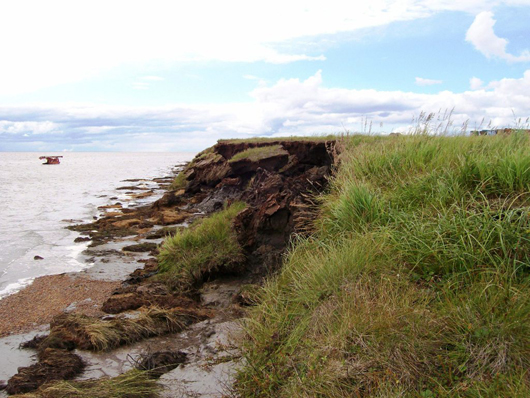How doom and gloom climate coverage fails the Arctic
ANALYSIS: Much of the climate journalism produced about the Arctic gets the problems right — but ignores the resilience of local communities working toward solutions.

Elizabeth Arnold, a former National Public Radio political reporter, spent the early months of 2018 researching the way the story of climate change in the Arctic has been told by national media.
She documented a pattern of predictable reporting that sounds the alarm on climate change and conveys a catastrophic vision, but little more.
The Arctic is warming faster than elsewhere and threats to coastal villages have made a compelling and emotional story, backed by powerful images of houses precariously balanced on shaky ground.
But what’s missing from the national reporting, she said, is any sense that solutions are possible.
“While it’s important for the public to understand and see this threat, it’s also important for the public to see and understand how people are responding,” she said.
Arnold spoke last month at an Arctic Research Seminar in Washington, D.C. on the role of major media organizations in “public disengagement” about climate change (you’ll find video of the talk at the end fo this column, and you can find more information here).
Arnold, an associate professor of journalism at the University of Alaska Anchorage, covered Congress and the White House for many years on the NPR news programs.
She cited research that people are tuning out at a time when they ought to be tuning in.
In the last few months Arnold has been thinking about this as a Joan Shorenstein fellow at the Harvard Kennedy School Shorenstein Center on Media, Politics and Public Policy.
As an example of coverage gone awry, Arnold mentioned the recent history of Newtok, a village in southwest Alaska that is close to being washed away by erosion.
She traveled to Newtok for the first time a decade ago to report on the effort to move the village to higher ground.
Since then the story of Newtok and about a dozen other remote Alaska towns threatened by climate change has been told the world over.
“The national stories largely fit the very same narrative pattern,” she said, with reporters including phrases like “impending doom” and “cultural extinction.”
The national and international reporting portrays the villagers as victims “to sell the urgency of mitigation to the public,” she said.
“The repetition of this narrow narrative in national and international media for the last 10 years hasn’t resulted in a groundswell of support for mitigation or adaptation or much in the way of funding for relocation,” she said.
It hasn’t led to changes in public policy or to the creation of specific government agencies to deal with the problem.
“It may have even undermined the ability of these coastal communities to help themselves,” she said.
Part of the problem is that reporters who fly to Newtok know exactly what they want to cover, she said. They are not looking for a story about resiliency or adapting to changing conditions.
“They already have the story written. They want to do a story about climate victims, climate refugees and tell that story. Period.”
Pointed questions lead to predictable answers.
But the residents of Newtok and other villages are not victims and have been taking incremental steps to do something about their situation for years, she said.
Leaving the response out of the coverage, fosters a sense of powerlessness with the audience, prompting people to look away, she said.
“These stories frame communities as endangered and entirely incapable of responding,” she said.
If the word “strong” comes up, it is to mention strong storms or strong resistance in Congress, not the character of the residents.
“If the story does include a response they’re framed as obstacles,” she said, such as the impossibly high price tags of relocation.
In May, the Denali Commission approved spending $22 million more, most of it federal money, to advance the relocation.
“We journalists most likely fail to tell the solutions part of the story on any consistent basis because it’s not as dramatic and it smacks of advocacy,” she said.
“If you pair the science with what an individual can do about it, it looks like you are making an argument for a specific action, so it’s left out,” she said.
But just as no reporter covering a flu epidemic would fail to mention if a vaccine is available or how the disease is transmitted, no reporter covering climate change should skip the part of the story about solutions and innovation.
She said that Newtok has made major progress toward moving because of government grants, with about 24 houses expected to be livable at the new village site, called Mertarvik, by the end of this summer, about 9.5 miles away on solid ground.
“It’s a process that’s worth documenting for the same reasons so many media outlets sent correspondents to Newtok in the first place,” she said.
“People of Newtok are undaunted by the challenge and their community will not cease to exist. In fact, life just might be a little bit better on higher ground, with fresh water.”
“It’s a story that provides a more complete view of society and it’s maybe even a story that’s inspiring,” she said.